A while back ol' Hal scores on a Kevlar Explorer vintage 83 if I'm correct. If I said it was treated well I'd be a liar. The stems were horribly treated and needed a lot of attention. One needing a total rehab, meaning filling in the baseball bat hit with thickened epoxy and then laying over a skid plates.
I don't know what that greenish crap is but it sure made a mess sanding off and I was wondering, as I usually do, about breathing in that waste! It was fugly but we got it done nice and smooth.
So here was the kicker in this tale. We had nice and comfortable temperatures all week but of course this is Scooter and Hal we're talking about so Mother Nature decided to turn the thermostat down for this endeavor! A mere 37 degrees with gusting winds. Our plan was to fill the divet, put on skid plates, put in seats and have it ready to go home with Hal. Gotta love a plan but they can go badly on a whim.
Friday night finds Hal here with the boat. We get it into the work cradles and start looking it over. From previous talks we decide to put in the seats first so the hull would be stiff enough as well as carry handles. The gunwales were and are suspect, old but doable.
 | |
| First Carry Handle. Please ignore the face of Hal |
We also got an original seat in from his old and weather beaten Explorer we call the Hand Basket a hull that has paddled more rivers then you can count.
Since we had limited time we flipped the hull over and started tackling the "Green Shit". I've seen this before on some hulls I've worked on, usually some type of construction adhesive. Using the RO sander we slowly and carefully ground that crude off although we should have probably worn some type of masks.
With that done there was one last task for the night. The second seat had cane in it and it was ripped. Aww Gawd, how I hate cane seats! We shut down the shop for the night and took the seat inside and I heated up the tea kettle with water and got it boiling. A couple of small screwdrivers to get at the spline and boiling water was all that was needed to get that damn cane out! In the past I've had trouble getting the spline out without breaking apart but this came out in one piece and took all of literally a minute! Hell, didn't even have to sand any part of the seat.
The plan for Saturday was to web the seat, mark out and tape for skid plates and do all the resin work.
3/19/2016
Saturday morning found us only in the 30's with a steady wind and it was one of those damp, cold and raw days. I had my doubts about any resin work. Waiting to see if it warm up some we worked on the webbing the seat. I wish I had taken pictures of this process but my camera was no where to be found only later to be in plain sight! I had some rolls of black, rainbow, pink and orange webbing. Since it was Hal's seat I let him pick and choose and I will admit it came out pretty damn nice looking!
So the day never warmed up very much and working in an unheated shed was pretty brutal with cold tools. We kept taking breaks to go warm up and it was obvious that we weren't going to do any resin work so the decision was made to leave the boat here and let me do the skid plates when it warms up later this week. Our last task was to tape out and cut for the plates. It was good to work with another boat tinkerer. Between the two of us we had enough knowledge and tools to make everything go smoothly. So there is a bit more to come!
March 26, 2016
Holy Crap it got warm out today! I waited until around two o'clock for the shed to warm up. In the meantime I had to make some templates of the skid plates. For this I used wax paper taped down.
I labeled both ends but was not very happy about how far down the stem they traveled. Lots of crinkles in the wax paper templates but adjustments can be made in the final cut on the Dynel. Not the first time. Next was filling the "Dimple" as I call it. I used West System 206/105 resin with a healthy dose of G-Flex mixed in. I opted to mix this in the house though. It needed a thickener and added 406 Colloidal Silica to make it the thickness of peanut butter but in the end had to add more. Gravity was having its way with the mix. I put the Peel Ply on and smoothed everything out best I could.
In order to get the correct curve I'm going to have to add another layer other wise that skid plate will be messed up. Now here's the screwed up thing in this tale. I'm using Green Peel Ply. That means it is time sensitive for adhesion. It has be pulled off around the two hour time line or it will become part of the patch. I had some thoughts that due to the cooler weather the resin wouldn't be totally set up but the PP would be starting to stick. I wasn't far off. Peeled off the patch and it held liked I hoped it would but not being a trusting idjiot I ventured out to the shed an hour later. Yup, sagging had happened but the nice thing was it was all still pliable enough to move around with a putty knife and could smooth it out. After the next layer I'll run my OR sander over it and then move on to the skid plates.
More To Come.
April 2, 2016
For the last week I have been messing around with that divot in the stem of this boat. Twice using thickened epoxy and peel ply I tried to fill it but due to using the time sensitive peel ply I had to pull it off and the damned epoxy sagged. In the end I used some plumbers epoxy to fill that void. Probably should have done that in the first place!
Today Hal is coming back to the Humble Hovel so we can get the skid plates on. I've tried three different times to make a template, cloth, newspaper, waxed paper, only to have them come out with more wrinkles than I can describe and knew they would be off. I think this is due to the fact that we are trying to cover almost to the tips of the stems which is a long stretch and something I haven't done before. I wanted Hal to be here to try to figure this out which I think will be a two piece process for each stem.
We decided on making a two piece skid plate, the first piece coming from the back end and then laid down a thinner strip to marry up to that one. Before we got working on the template though Hal wanted to do a little more sanding on the sag area and then we added a little more Plumber Epoxy.
Honestly, it turned out just about perfect, like that hull had never hit a rock that hard. We were grinning. We then cut out a template and for the second add on we measured out and took that up to the house where we'd be cutting Dynel and mixing resin. Still pretty cool out and of course with Hal in attendance it started raining.
 |
| Part one of the Template |
 |
| Cutting out |
 |
| Measuring for Part of Skid Plate |
For a clean cut we used a razor blade, a trick I learned from Mr. McCrea and is really the only way to go. Of course we forgot about cutting on the bias but it did turn out well. What strands that came out mostly came from wetting out the cloth.
What we used was West System 105/206 with G-Flex mixed in and then a dose of black pigment.
Next was nothing more then spreading resin and laying out the cloth. It went straight forward.
 |
| Checking for air bubbles and bends in the cloth |
Of course we had to spend a fair amount of time baby sitting the resin to make sure we got all of the bends in the cloth tapped down and then we put on the Peel Ply which took care of the rest we hoped. As usual the second skid plate went on much cleaner then the first.
So now because we were using that cursed time sensitive Peel Ply we got lunch and watched a movie. Before we did that though we placed a heater underneath the hull and put Halogen lights near one end as well hoping it would help heat up the hull and the drying process.
When we went back to check on things a couple hours later we had good luck, mostly, with the first patch. The hull was warm to the touch and the peel ply was were it should be, difficult to pull off and the Dynel was smooth as hell. But where the bulkhead prevented the heat to get to it wasn't as good.
The following pics are of Hal pulling the Peel Ply off. Takes two hands and is a bear.
 |
| Top 1/4 smooth, rest not as smooth |
One section was smooth as a baby's arse but the other where the heat didn't hit was still rough. We took plastic wrap and covered it then taping it down while smoothing it and called it good. Now on the other stem because we started later it wasn't cured yet. After much discussion/head and ass scratching we decided to cover it with plastic wrap with the Peel Ply still on and taped it down for the drive back to Hal's abode.
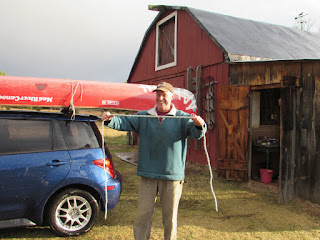 |
| This Hunk o' Rope is from the McCrea bag of rope scraps |
So in the end Hal will have to deal with taking the Peel Ply off the one end and then deal with maybe painting a hair to blend in the bleeding of resin. What was great was Hal hadn't dealt with the materials we used and was happy as a pig in poop with the results. A great learning experience for both of us. What is one of those priceless moments is the how well we work in a shop together. Like minded canoe dubbers makes for a good shop work session.
So, I am waiting to hear from Hal as to how that last piece of Peel Ply pulls off so I guess there is a bit...
More To Come.
The report from Hal was when he got home the peel ply pulled off leaving a nice smooth surface. The plastic wrap we used did leave a few almost noticeable wrinkles but as he said, "I'm not complaining." Now he has to spend some time putting in a new Teal carry thwart and re-web the front seat. It turned out I did have enough rainbow webbing to finish it off.





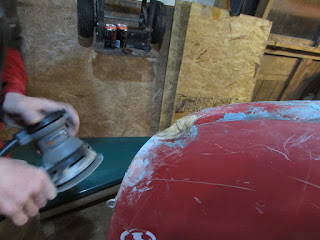





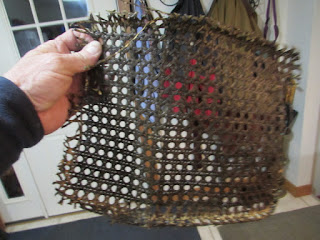

































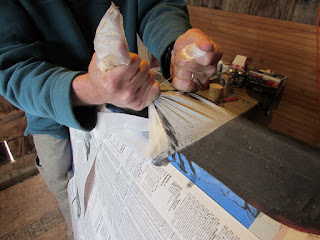
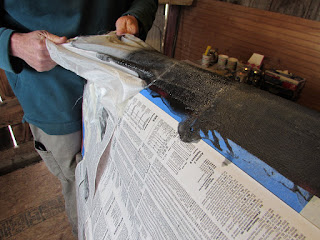















That webbing cutting trick of yours is pretty slick. Hal
ReplyDeleteNice start, that canoe has alot of potential, should be a good one, but please, re-web that front seat to match the nice stern seat.
ReplyDeleteSorry to hear the white Explorer is retired. It's always bitter-sweet when a boat runs that last river.
ReplyDeleteWell done on the seat. Am I missing something? Which cutting method?
ReplyDeleteJason
Jason, heat a putty knife with a torch, lay the webbing down on a cutting board and just push the hot knife through it. Cuts cleanly, easily and no fraying.
ReplyDelete